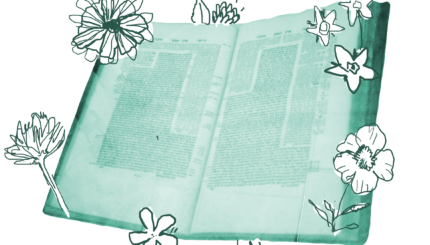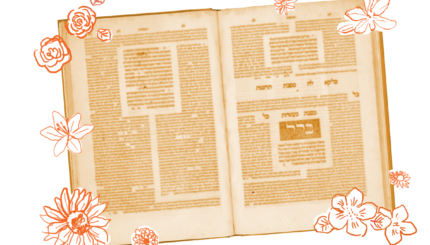Reprinted with permission from Jewish Ideas Daily.
The Jewish prayer book (siddur) is thick with texts: blessings, thanksgivings, and petitions, instructions, theological claims, and historical memories. Some traditional texts bear especially outsized burdens. In this respect, few can rival three lines that begin “Blessed are you O God, King of the Universe, Who has not made me…” and conclude, respectively, “a goy [Gentile],” “a slave,” and “a woman.”
These three blessings, a standing provocation to all sorts of sensibilities, are at the center of a new book on the Jewish liturgy. Its author, Yoel Kahn, traces their history from antiquity down to the present, illuminating how they have been interpreted, revised, translated, excised, and, in varying ways, restored.
The three lines are embedded in a string of similarly-worded formulas that open the preliminary morning prayers known as birkhot ha-shahar or the “dawn blessings.” Most of these thank God Who “gives the rooster understanding to distinguish day from night…gives sight to the blind…clothes the naked…raises those who are bent down,” and so forth. They appear in the Talmud (Berakhot 60b) and, as presented there, are meant to be recited in private at home as one starts the day: awaking, opening one’s eyes, dressing, standing upright, and so on. Today we might call them an exercise in mindfulness, aligning our consciousness with the acts that knit together our daily routines and, as Kahn points out, heightening our awareness of God’s hand at work in the world.
Where Do They Originate?
The three blessings in particular seem to have originated outside Jewish circles. From the third century B.C.E., we find written record of a quip, ostensibly attributed to Socrates, that expresses gratitude for having been born human and not a brute, a man and not a woman, Greek and not barbarian. An analogous one-liner circulated in Zoroastrian circles. The Jewish formula, a version of which first appears at about 200 C.E., was unconnected with the dawn blessings and was recorded in a different tractate of the Talmud (Menahot 43b).
That changed during the centuries known as the Geonic period, when the great yeshivas of Babylonia emerged as the leading institutions of Jewish learning. The first text featuring both sets of blessings is the Sefer Halakhot Gedolot (“Book of Major Laws”), circa 750-825, and soon thereafter they were amalgamated into a single set. Although the details of the liturgy remained in flux for centuries, by the early Middle Ages the basic text had stabilized into what we know today: the full complement of blessings, recited not at home but in the synagogue.
In the 13th century, the Church, for reasons of its own, began to take a vigorous interest in the contents of Jewish prayers. As, with time, the Inquisition expanded its writ and printing enhanced the reach of the censor, Jews began to insert an “explanatory note” to the effect that mention of Gentiles anywhere in the siddur referred not to Christians but to proper heathens. When it came specifically to the goy of the dawn blessings, Jews also took positive action to alter the text: either substituting a euphemism (like “Samarian”), employing the affirmative statement, “Who has made me a Jew,” or skipping the line entirely. Sometimes the same scribe would have recourse to all three. But while the Church may have succeeded at times in driving the word into the shadows, it may also have inspired its preservation. Kahn: “If the effect of censorship and expurgation was to muzzle Jewish religious speech, this blessing was an act of spiritual resistance and identity-formation that reasserted the superiority of the Jews over the Gentile oppressors.”
The “slave” blessing was problematic for another reason. The Hebrew word eved means not only slave but also servant and, more to the point, serf—which is just what many Jews in medieval Europe were. Some therefore eliminated the blessing altogether, some embellished it (as in: “Who did not make me a slave to humans”), and some replaced the troublesome word with “boor” or “beast.”
What about “Who has not made me a woman”? The first real alternative phrasing for women at prayer was “Who has made me according to His will,” which appears early in the 14th century in the authoritative code of Jacob bar Asher. It seems to have been intended as an expression more of acceptance than of empowerment, though it also testifies to the engagement of women in the religious life of the time. In southern Europe in the 14th-15th centuries, women using the Judeo-Provençal vernacular adopted a more assertive stance, intoning “Who did not make me a man” or “Who made me a woman.”
There were also internal, Jewish critics of the dawn blessings who were troubled not by any anti-Gentile content but by the danger of the formulas’ becoming so ritualized as to be detached from lived experience. Two such critics were Maimonides and his son, the Judeo-Sufi pietist Abraham Maimuni. They were joined by the Franco-German pietists known as Hasidei Ashkenaz, whose richly mythic worldview otherwise differed greatly from Maimonides’ rationalism. By contrast, the later kabbalists saw good reason for ritualizing the blessings: after all, they sustained the social and, implicitly, the cosmic order, both of which were threatened in the nighttime when the spirits of darkness were afoot and the unconscious soul experienced the whiff of death.
The Standardizing of Jewish Texts
Meanwhile, the advent of printing standardized the texts of these and other prayers like never before. But then, starting in the 18th century, once emancipation came around, the three blessings became problematic again—not only because of Christian sensitivities but because of the Jews’ own aspirations to merge their particularity with the values of the broader society. “Not surprisingly,” Kahn observes, “not a single 19th-century European liberal prayer book includes ‘did not make me a Gentile’ in Hebrew.” Even unimpeachably Orthodox figures changed the wording from goy to nokhri (foreigner), a term shorn of the negative connotations accrued by the former word over the centuries.
In America, liturgists were freer still. By 1872, almost a decade after slavery had been abolished in the nation, “Who did not make me a slave” was gone from Reform prayer books, to be followed by the removal of the other blessings from the 1895 edition of the Union Prayer Book. Proto-Conservative siddurim like Avodat Yisrael of 1873 replaced the three blessings with one: “Who made me an Israelite.” The leading modern-Orthodox siddur of the 20th century, by Joseph Hertz, substituted nokhri for goy and added an elaborate apologetic commentary: “He who would serve humanity must first of all to himself be true.” As for “Who has not made a woman,” it was glossed as “Who has set upon me the obligations of a man,” while the corresponding blessing recited by a woman thanked God for allowing her “to win hearts for Thee by motherly or wifely devotion.”
The Blessings Today
And today? Unfortunately, Kahn does not investigate the work of Israeli liturgists of various denominations. He does, however, attend to the further evolution of Reform and Conservative prayer books—and, pointedly, to the Artscroll phenomenon, in which everything old has become new again. (The Artscroll siddur contains the three blessings in unadulterated form, asserting unapologetically that “The Torah assigns missions to respective groups of people.”)
Toward the end of his study, Kahn also offers interesting reflections on his experience in his own synagogue in San Francisco, a gay community that has proved more than willing to re-engage traditional liturgies from its perspective of theological agnosticism and commitment to inclusion: “Who has led me to my Jewish heritage…Who has made each of us unique, and all of us according to Your will.” Today’s non-halakhic communities, he notes, perhaps because they are more distanced from the old texts and the forms of authority that accompanied them, are more eager than their immediate forebears both to appreciate those texts and to experiment with them.
The world in which the ancient prayers emerged was one in which clear social boundaries and correspondingly well-defined roles were a value and an end in themselves, however imperfectly realized in practice. Today, the category of slave has been discarded with a moral vehemence that can only be termed religious, and that was nourished in no small measure by both Scripture and the historical experience of Jewish suffering. The second two categories, distinguishing between man and woman, Jew and Gentile, are still with us but in a continual process of redefinition that shifts once-fixed expectations, rights, and responsibilities by seeking to minimize friction and maximize the reach of human freedom.
Can God ground and guide these explorations as He once guaranteed those boundaries? That would be blessing indeed.
siddur
Pronounced: SIDD-ur or seeDORE, Origin: Hebrew, prayerbook.
Talmud
Pronounced: TALL-mud, Origin: Hebrew, the set of teachings and commentaries on the Torah that form the basis for Jewish law. Comprised of the Mishnah and the Gemara, it contains the opinions of thousands of rabbis from different periods in Jewish history.
Torah
Pronunced: TORE-uh, Origin: Hebrew, the Five Books of Moses.


